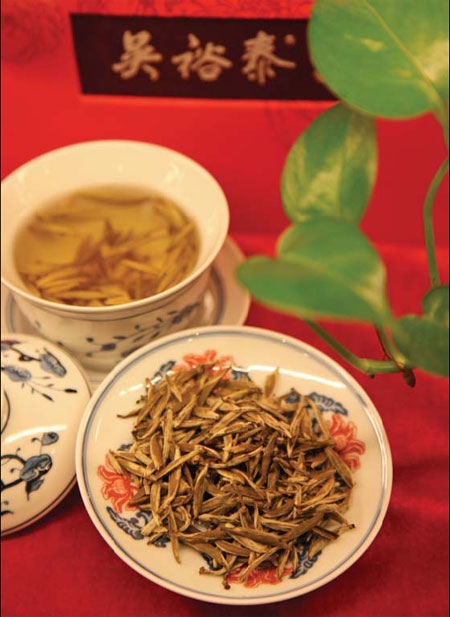Old name, fresh face
Updated: 2012-04-20 08:46
By Xiao Xiangyi (China Daily)
|
||||||||
|
 Wuyutai, established in 1887, is famous for its high-quality tea. Provided to China Daily
|
Wangzhihe's cooking wine is a mixture of rice wine and spices, such as pepper and anise seed, as well as ginger. The company's cooking wine is currently one of the top choices for Chinese customers because of its brand power and unique flavor.
Chen Hongxuan, general manger of Wangzhihe, says the choice to focus on wine was a natural one. "It is quite common for a Chinese family that cook once a day to use up a bottle of wine each month because it is almost a must for cooking," Chen says. "But not every family would buy the furu."
Wangzhihe makes nearly 100 different types of sauces, from sesame oil, soy sauce to sweetened bean paste. Its newest product is a refined furu with a lower salt content. Through its wider range of products, the company is aiming to generate 800 million yuan in sales this year.
Most time-honored firms have experienced decades of being operated jointly by the State and private owners since the 1950s but were left without the shelter of the government after the reform and opening up.
"That's when we got the first stimulation to rely on ourselves, and were determined to reshape our brand," Chen says.
The brand is registered in 41 countries around the world, which Chen says has helped in boosting sales overseas. Wangzhihe began exporting its goods in 2001 and most of its overseas consumers are Chinese who live abroad but more than 90 percent of Wangzhihe's sales take place on the Chinese mainland.
But "another reason why we've kept a double-digit growth since 2000", Chen says, is because the company has evolved how it produces its goods.
Wangzhihe opened its own manufacturing factories in 2000 and spread them throughout nine provinces in China. It soon will have its own design facilities to create new products.
Another example of a Chinese brand that has altered its business model is silk shop Ruifuxiang. The shop was founded by Meng Luochuan - a descendent of the Chinese thinker Mencius - in 1893 in Beijing. In the beginning of the 20th century, it had grown to become the biggest silk and cloth shop in the capital.
But instead of simply providing fabric, the Ruifuxiang store in Qianmen, another shopping street in Beijing, provides a number of choices, from silk scarves, silk quilts, pajamas and qipao (a tight fitted women's dress).
"People are more likely to buy ready-to-wear clothes, so we sell half fabrics and half finished goods," says Wang Qiang, sales and marketing manager of Ruifuxiang. "In order to maintain our tradition and target high-end customers, we did not quit selling the cloth, so we provide new services like tailoring accordingly. After all, Ruifuxiang started off by selling fabric."
Tailoring, Wang says, is the company's way of being innovative and also preserving its tradition. Ruifuxiang once had 106 chains around China in 1927 but not a single chain store remained after the "cultural revolution" (1966-76).

 Relief reaches isolated village
Relief reaches isolated village
 Rainfall poses new threats to quake-hit region
Rainfall poses new threats to quake-hit region
 Funerals begin for Boston bombing victims
Funerals begin for Boston bombing victims
 Quake takeaway from China's Air Force
Quake takeaway from China's Air Force
 Obama celebrates young inventors at science fair
Obama celebrates young inventors at science fair
 Earth Day marked around the world
Earth Day marked around the world
 Volunteer team helping students find sense of normalcy
Volunteer team helping students find sense of normalcy
 Ethnic groups quick to join rescue efforts
Ethnic groups quick to join rescue efforts
Most Viewed
Editor's Picks

|

|

|

|

|

|
Today's Top News
Chinese fleet drives out Japan's boats from Diaoyu
Health new priority for quake zone
Inspired by Guan, more Chinese pick up golf
Russia criticizes US reports on human rights
China, ROK criticize visits to shrine
Sino-US shared interests emphasized
China 'aims to share its dream with world'
Chinese president appoints 5 new ambassadors
US Weekly

|

|






